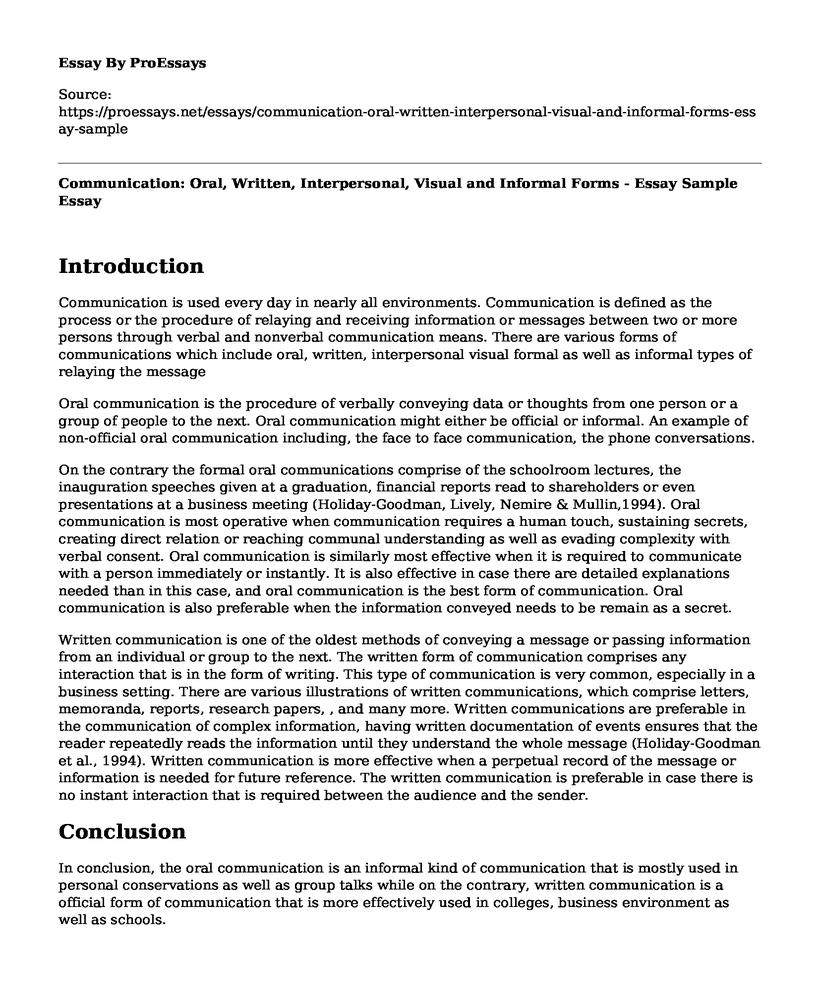Introduction
Communication is used every day in nearly all environments. Communication is defined as the process or the procedure of relaying and receiving information or messages between two or more persons through verbal and nonverbal communication means. There are various forms of communications which include oral, written, interpersonal visual formal as well as informal types of relaying the message
Oral communication is the procedure of verbally conveying data or thoughts from one person or a group of people to the next. Oral communication might either be official or informal. An example of non-official oral communication including, the face to face communication, the phone conversations.
On the contrary the formal oral communications comprise of the schoolroom lectures, the inauguration speeches given at a graduation, financial reports read to shareholders or even presentations at a business meeting (Holiday-Goodman, Lively, Nemire & Mullin,1994). Oral communication is most operative when communication requires a human touch, sustaining secrets, creating direct relation or reaching communal understanding as well as evading complexity with verbal consent. Oral communication is similarly most effective when it is required to communicate with a person immediately or instantly. It is also effective in case there are detailed explanations needed than in this case, and oral communication is the best form of communication. Oral communication is also preferable when the information conveyed needs to be remain as a secret.
Written communication is one of the oldest methods of conveying a message or passing information from an individual or group to the next. The written form of communication comprises any interaction that is in the form of writing. This type of communication is very common, especially in a business setting. There are various illustrations of written communications, which comprise letters, memoranda, reports, research papers, , and many more. Written communications are preferable in the communication of complex information, having written documentation of events ensures that the reader repeatedly reads the information until they understand the whole message (Holiday-Goodman et al., 1994). Written communication is more effective when a perpetual record of the message or information is needed for future reference. The written communication is preferable in case there is no instant interaction that is required between the audience and the sender.
Conclusion
In conclusion, the oral communication is an informal kind of communication that is mostly used in personal conservations as well as group talks while on the contrary, written communication is a official form of communication that is more effectively used in colleges, business environment as well as schools.
Reference
Holiday-Goodman, M., Lively, B. T., Nemire, R., & Mullin, J. (1994). Development of a Teaching Module on Written and Verbal Communication Skills1, 2. American Journal of Pharmaceutical Education, 58, 257.
Cite this page
Communication: Oral, Written, Interpersonal, Visual and Informal Forms - Essay Sample. (2023, Apr 05). Retrieved from https://proessays.net/essays/communication-oral-written-interpersonal-visual-and-informal-forms-essay-sample
If you are the original author of this essay and no longer wish to have it published on the ProEssays website, please click below to request its removal:
- Socialization Report Paper Example
- Effects of Divorce on Child Development Essay Example
- Working of Visualization Tools and Social Network Utilization
- Essay Sample on Social Change: An Inevitable Element of Society?
- Essay Sample on Overcoming Fear: African-Americans & the Fight for Equality
- Paper Example on Restorative Justice: An Overview of Programs and Benefits
- The Division of Duties Along Gender Lines - Essay Sample







